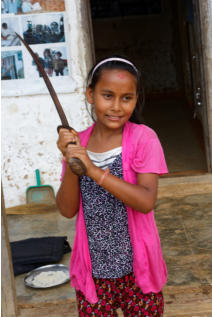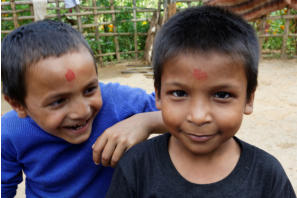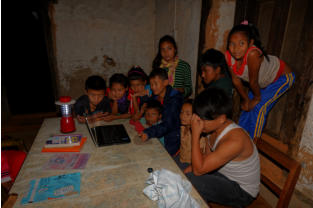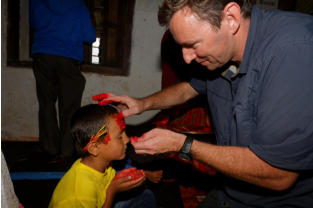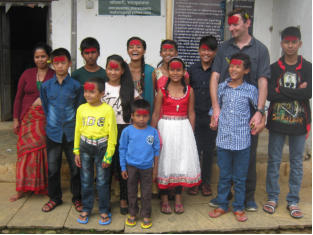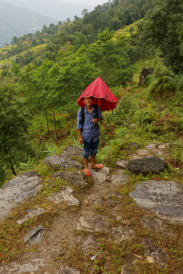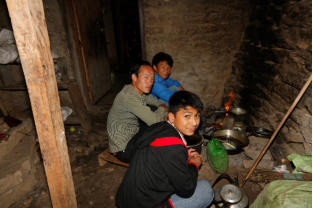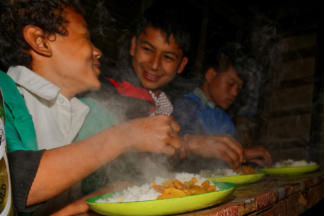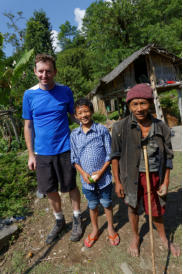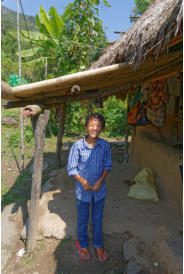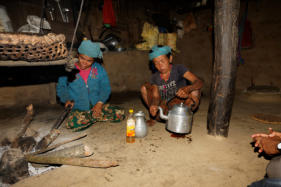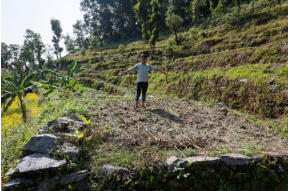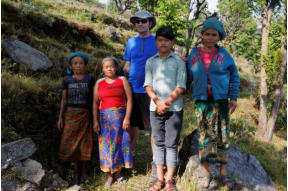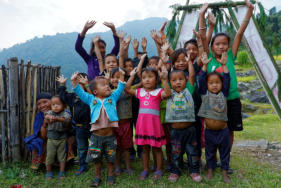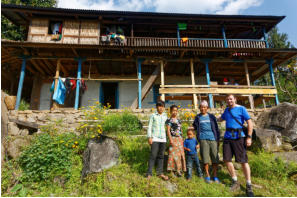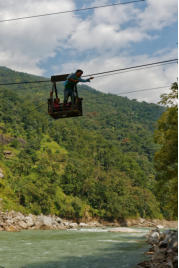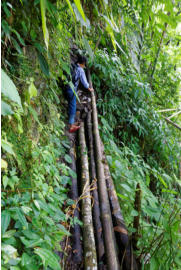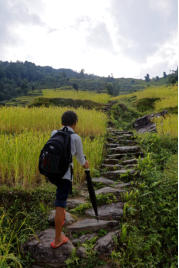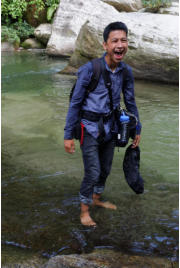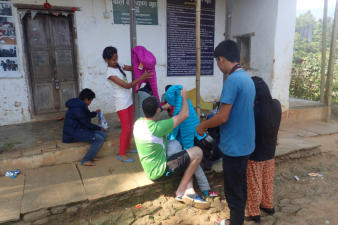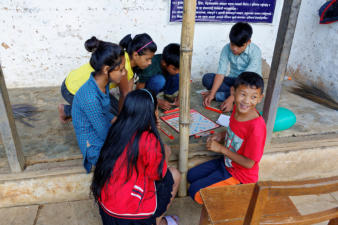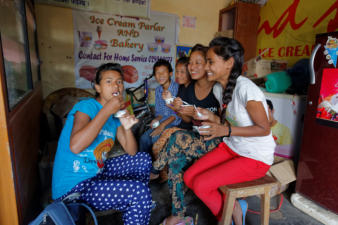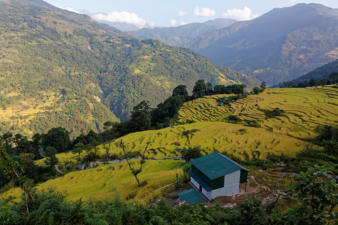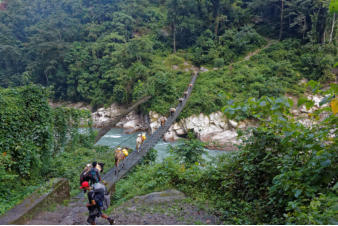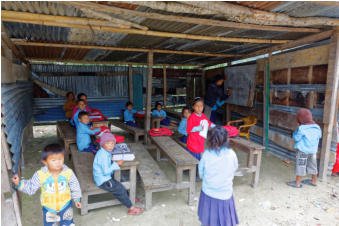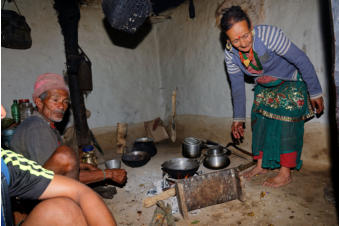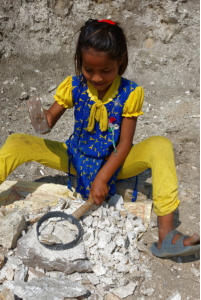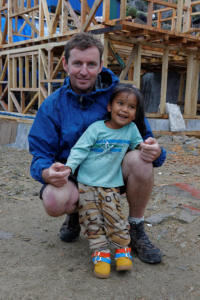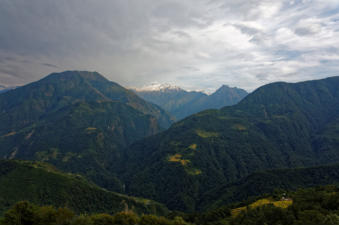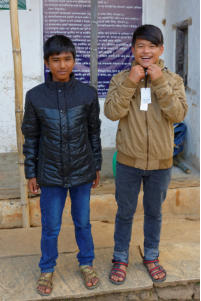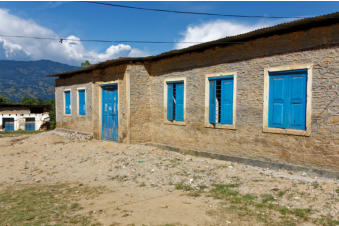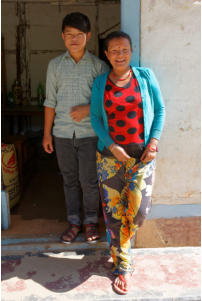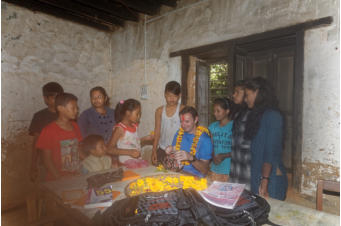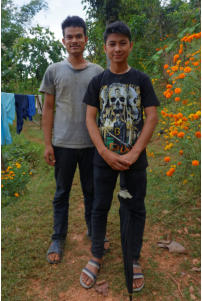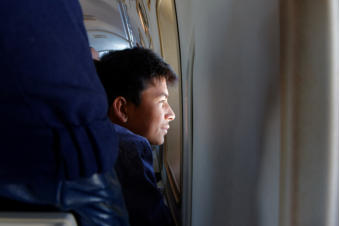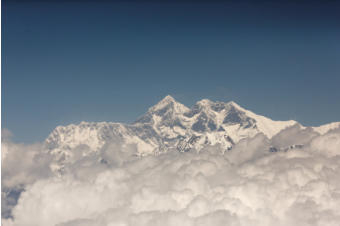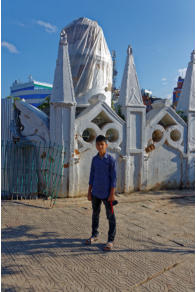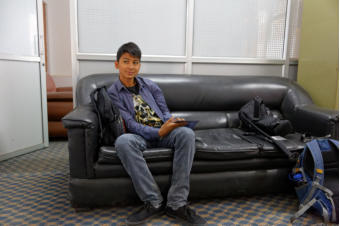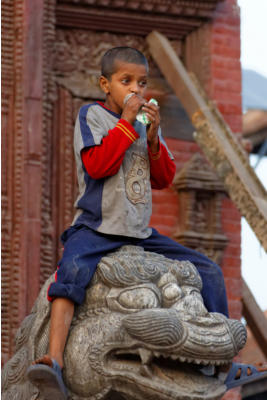








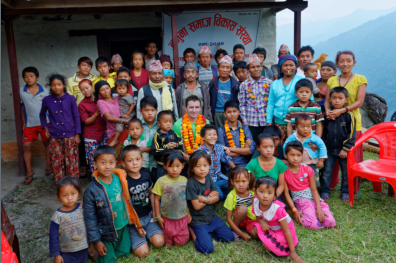

Important Note: It is important to understand that all trips to Nepal are self funded and no money
donated to help the children will be used for travel expenses incurred by organization staff. This is explicitly
specified in the bylaws of the organization.
In October 2015 I returned to Khandbari for the 4th year in a row. The main plans for this trip were to bring Sundar
and Sammar to their villages to reunite them with family and to bring Rabin to Kathmandu to visit prospective
schools for him to attend once he finishes the School Leaving Certificate (SLC).
As with previous years I funded a goat for the children. It is traditional to sacrifice a goat
during the Dashain festivities but more importantly for me it means they get a good
dinner. I wasn’t arriving in Khandbari until the day after goats are usually sacrificed but
the children insisted the goat get a stay of execution (literally) until I arrived. On the
morning of Maha Asthami (the 8th day of the Dashain festival) I visited the Shobha
Bhagwati Temple in Kathmandu to see how
Kali, the most destructive form of the Hindu
Goddess Durga, is appeased. I then took the
short flight from Kathmandu to Tumlingtar
and arrived in Khandbari in the early
afternoon. Rabin was waiting at the airport in
Tumlingtar. We took a jeep to Khandbari and I
went over to see the other kids as soon as I arrived. It was great to see all
their smiling faces.
One of the things I brought the kids this year was a laptop computer. I
loaded all of the Khan Academy videos (http://www.khanacademy.org) and
the KALite software (http://learningequality.org) so they could use the Khan
Academy software without an internet connection. Nearly all the children
struggle with Maths and Science so I was hoping the Khan Academy
tutorials would help.
I also brought the Star Wars films to watch with the kids. On my first night
we had a movie night and watched the first of the Star Wars series. They
really enjoyed but I think they are still confused why I made them watch
number four first.
I usually align my trips to Khandbari with the Dashain festival as I know the
weather will be good (after the monsoon but before winter bites) and the
children will be on a break from school. The biggest day of the Dashain
festival is the tenth day, Vijaya Dashami or Tika day. On this day elders put
Tika (a mixture of rice, yogurt
and vermilion) on the
foreheads of children. They are
also adorned with Jamara. These are young shoots of grains
(like barley) that are planted on the first day of the Dashain festival and
are a few inches tall by the tenth day.
In previous years I have received Tikas from friends in Nepal but this
year I had the honor of giving Tikas to all of the children at the home. It
was a very happy occasion. First cookmother gave the kids Tika, then I
gave to each of them and then I also received a Tika from cookmother. It
was really nice to participate in Nepali culture. In the afternoon I also went with Rabin to his uncle’s house and
received another Tika there.
The morning after Tika day Sundar, Sammar, Santosh and Rabin arrived over to Tejanath’s
house around 6am. We had breakfast (Dal Bhat) and then set out to walk to Yaphu, the
region where both Sundar and Sammar come
from. On the way we met our two guides who
would help us find their relatives in the hills.
As in previous years the kids arrived with no
rain gear and just a small bag each with a
change of clothes. We stopped in
Manebhanjyang and I bought them each an
umbrella as we were still in the tail end of the
monsoon season. Stopping to buy umbrellas is
turning into a tradition.
After a few hours walking the skies opened and proved monsoon was
still around. Not long later Sundar’s umbrella broke. He carried on with
his broken brolly and big smile.
It was a long and extremely tough day of walking with some very long
and steep climbs. We crossed the Arun river and then it was all climbing
up the far side of the valley. The Arun river is the deepest river valley in
the world. We arrived in Yaphu after dark. We were hoping to travel
further but decided to seek accommodation in Yaphu. The local
teahouse agreed to us staying but as it was late and it was still
Dashain the owner had no interest in cooking for us. Our guides
and the kids cooked Dal Bhat.
The next morning we walked a little further and got to the house
where Sundar was born. We met his aunt and his granduncle (I
believe the brother of his maternal grandfather).
His granduncle told us Sundar was born under the shelter in front
of the house. Some locals came along and were happy to see
Sundar. They remembered a child being born at the house but had
no idea what had become of him. I know the history of all these
children but choose not to post details on such a public forum. I
did learn that Sundar’s mother is living in Kathmandu and do hope
it is possible to reconnect them in the future.
After spending some time with Sundar’s relatives we carried on to find Sammar’s family. We found his aunt who was
crying with happiness after seeing him. This was one of the more emotional reunions I have seen to date.
Sammar’s aunt brought us to the spot where Sammar’s family house used to stand. It sounds like Sammar may have
a claim to the land though the house is no longer standing. Sammar is hoping to go spend a month with his aunt next
summer.
As it was getting into late afternoon we had to leave and make our way to Waleng where we
had plans to stay for the night. Yaphu is a large area and we were moving from Yaphu 4 to
Waleng which is in Yaphu 5.
As it was getting late we took a local trail. Nepali shortcuts are always interesting. Even tourist
trails can be steep and challenging but local
shortcuts are a different level altogether. We had a
super steep descent to a stream and an equally
steep climb up the far side. As I was the clumsy
westerner Sammar took my bag and carried it down
the steep section of the trail.
When we arrived in Waleng many of the villagers
were waiting at the local community hall. They had prepared flower garlands
and gave us a huge welcome with garlands and prayer scarves. They were
genuinely happy that we were helping two kids from their community and really offered heartfelt thanks.
One of the locals hosted us all that evening. The hospitality was amazing. They fed us Dal Bhat with Chicken and I also
drank Tongba.
We had planned to leave Waleng the next day and travel to Seduwa. I wanted
to visit strongman (SukBahadur), one of my guides from the first year I was in Nepal. The locals in Waleng told us we
should even think about trekking with the kids to Seduwa as the trail is very basic, takes
locals over 12 hours to travel and there is no place to eat or stay along the way.
As we were eating Strongman arrived to Waleng. He had travelled from Seduwa to Yaphu
(where we stayed the first night) to look after me. When he heard we had gone to Waleng he
ran to reach us that day. He had travelled for 15 hours carrying a flask of tea and a small
backpack with biscuits to look after me. I had helped his family a little
after the earthquake and he came to show his gratitude. From that
moment he carried my bag and travelled where ever I did in the
region.
As we were advised not to travel along the Arun valley to Seduwa we
decided to return to Khandbari and then I would go alone to Seduwa
another day to visit Strongman’s family. To return to Khandbari from Waleng we had to cross
the Arun River. There is no bridge near Waleng but instead a Tuin, a metal basket hanging from
a single cable. It was a bit of an adventure for the kids.
After crossing back to the southern bank of the Arun it was an extremely steep and lightly
travelled trail up the first part of the valley. In places the trail had collapsed and bamboo was
used to replace the missing sections.
We were up and down valleys all day working our way back towards Arunthan and on to
Khandbari. The area known as Diding was very picturesque with rice paddies covering most
of the hillsides. Much of the day was walking paddy walls and aiming in a general direction
rather than following a known trail.
At one point we had to cross a stream and the banks were slippery
and damp. I gave Rabin my camera to carry as we crossed the stream
as I trusted his balance more than mine. As we got to the far side
Sundar slipped and fell into the river. I took my camera from Rabin to
grab a pick. Almost immediately Rabin also slipped into the river –
was glad I had taken the camera back. Rabin had a change of clothes
but poor Sundar only had the pants he was wearing and had to walk
the rest of the day in wet jeans.
As picturesque as it was the climb from the river through Diding to Arunthan seemed to
never end. The kids were all tired. I was lucky as strongman was carrying my pack. I took
Sundar’s pack for a while as he really was beat but next time we stopped he insisted on
carrying it himself again. We eventually arrived back to Khandbari three hours after dark. The ability of these kids
never ceases to amaze me. I don’t know many wester kids who could undertake such a tough day of walking and still
be smiling at the end.
The next day I decided to take a rest day in Khandbari before my visit to
Seduwa. I had brought a bag full of jackets from the US (thanks Gina,
Annie and Marcus for donating a number of those I brought). In the past
many of the kids have been sick during 2nd term exams as they didn’t
have appropriate clothing to keep them warm during the Himalayan
winter. I let the kids try and choose from what I brought and promised
to buy locally for those
who didn’t find
something suitable.
I also brought the game of scrabble. Each year I bring a toy for the kids
– something that doesn’t take batteries and hopefully challenges their
mind (in the past Rubik’s cubes, Jenga, Connect4). I was really amazed
by how much they
enjoyed scrabble. We
played a number of times
during my stay and they
even asked I bring the same game next year as the little guys had lost a
few of the letter chips.
I took the kids downtown to get ice cream – another annual even at this
point. While there Sundar asked if I would get him a pair or sandals as
he didn’t currently have any. I asked the other kids if they needed and all
replied no and that only Sundar needed. It always amazes me that these
kids who don’t have much are content with what they do have. I don’t know many western kids who would turn down
the opportunity to buy something new – regardless of whether it’s really a need or not.
The following morning I was up at 4am for the trip to Seduwa. We took a
jeep from Khandbari to Num (the end of the road). It was quite surreal
bouncing along the mud road in the darkness with Nepali dance music
blaring from the stereo. In Num I met a number of people I know from
my last visit there. The teahouse welcomed us and gave us tea. We then
went to the samosa shop
for breakfast.
Unfortunately no samosas
at that time of day but we
had more tea and chow mein. It was great to see Rupin. He was very
young during my first visit to Nepal and was recovering from an
operation to straighten both ankles. He was now fully recovered but still
as friendly as I remembered him.
After breakfast we tackled the journey from Num to Seduwa. This trip is
what’s known as Nepali flat – you start and finish at roughly the same
altitude. Unfortunately you have to drop about 4,000 ft down to the
Arun River and then climb the same distance on the opposite bank. I
kept my bag purposely light for this trip (strongman was carrying). We
managed to get to Seduwa in less than two hours – probably half the
time it had taken the previous time I had done this same trip.
Strongman had been
renting a house and
running a shop beside the school in Seduwa. Seduwa is far from where
the earthquake occurred and in general there was very little damage in
the Sankuwasabha region. For some reason there was a lot of damage
in this one village. The building strongman was renting was destroyed.
For the time I was in
Seduwa I stayed with him
and his family in his post-
earthquake shelter.
The school in Seduwa also sustained heavy damage. Some buildings
collapsed completely and others sustained serious damage. There is
one relatively new two story building. Although it didn’t collapse it has
been deemed unsafe and is unusable. Most classes are now held in
temporary classrooms that have been constructed in the school yard.
We went to visit strongman’s parents with whom I stayed during my first
trip to Nepal. They live in a small community just below the main village. Most of the houses in this little area
sustained heavy damage during the earthquake. You can see the walls of their house are leaning badly and the
building is now very unsafe. As most in that village, they still live in the
house as they have little other choice. His parents killed a goat to
celebrate my arrival and to thank me for thinking of them after the
earthquake.
The Korean government are funding a
replacement school in Seduwa. Strongman
has also bought a plot of land to build a new
house and it turns out he will again be beside
the new school. We went to visit his plot and
to see the progress on the new school.
Strongman’s current job is to run a kango hammer breaking the big rocks needed to
construct the new school. There was a poor family smashing those rocks into aggregate to
be used in the building. It was pretty shocking seeing one young girl working on the site.
She will probably never have the opportunity to attend the school that she is laboring on.
Child labour is an epidemic problem in Nepal and often the families need the income from
their kids just to survive.
When I first visited Nepal strongman’s first
son, Mausham, was just a baby. I had sent
the family photos from the visit including one
of me holding the baby. Mausham keeps this
photo as one of his prize possessions and
often asks about this white guy who was
holding him. Mausham is older now and was
super excited that I was visiting. I think he
may have introduced me to every person in
Seduwa and usually with ‘this is my Michael’.
After a couple of days in Seduwa I was itching to get back to Khandbari and spend more
time with the kids before I had to leave for Kathmandu. We walked from Seduwa to Num
and spent one night in the teahouse there. As we were walking a big storm hit dumping a lot of snow at higher
elevations. The hills really did look special from Num.
The centre of Num doesn’t really look as if it has much character. I think having the road has really changed the place.
As in the past I was really pleasantly surprised by just how friendly the people are there.
We left Num early and walked the few hours back to Khandbari.
That afternoon in Khandbari I decided to go shopping with those kids that didn’t find
suitable jackets in what I brought. It turned out Santosh and Sammar were the only ones
that didn’t find something that fit. I brought the two of them down to the shops in
Khandbari Pokhari. Sundar also came along – he is my special little guy and is like a
shadow when I am in Khandbari, never far from my side. While in the shop I asked Sundar
if there was anything he needed – any clothes I should buy for him. His response was that
he is ok and has what he needs.
We got jackets for Santosh and Sammar and
also for strongman’s son. We also visited the
government school (Himalaya Higher
Secondary School) to see damage the earthquake had done there. I had
visited this school during my first visit to Nepal. At that time there was
obvious damage to a number of buildings from an earthquake that
happened in the Kanchenjunga region in 2011. When the 2015
earthquake hit, these buildings sustained further damage. The current
situation is that some buildings are unusable and the second story of
the main building was removed so they could continue to use the first
floor classrooms.
While returning from Khandbari Pokhari Sammar asked me to go to his sister’s house for
Tongba and Pig. When Nepali people say brother or sister it doesn’t necessarily mean
family member but is often a friend or somebody from their village. This lady was from
Sammar’s village and is very fond of him. I really enjoy when the kids bring me to meet
their brothers and sisters around town. It is also great to know they do have a support
network in the community.
The following day was my birthday and the
kids heard about it. They asked me to be over
at their house at 8am on the morning of my
Birthday. When I arrived there they had
prepared a flower garland and had also
collected money amongst themselves and bought me a present. Sundar
was nominated to come present me with both and then cookmother
gave me a small Tika for the occasion. It was really touching that these
kids who have so little all contributed and bought a present.
My last day in Khandbari came far too quickly. Rabin needed his citizenship card to travel
but it was with his brother in Chewa. Rabin’s brother, who had been living in Biratnagar, is
now in Chewa as he waits to start a job in the gulf. Myself and Rabin walked to Chewa to
collect his citizenship card. We had snacks in the village with people I’ve gotten to know
over the years and then briefly visited his brother.
It was getting late when we got back to Khandbari so I went straight to the kids house to
spend the last evening with them. I ate dinner with the kids and then we sat around
talking. I got many of the kids to sing for my video camera. Nabin in particular was
surprising in how well he sang. It was well after dark when I decided it was time to leave
so cookmother and many of the kids walked me back to Tejanath’s house. It was really
tough saying goodbye to them.
The next morning myself and
Rabin took a jeep to
Tumlingtar to catch the flight
to Kathmandu. It was fun to
watch Rabin enjoy the view
from the airplane. You fly past
Makalu, Everest and Lhotse –
three of the highest
mountains in the world. His
look of amazement was quite understandable.
That first afternoon in Kathmandu we went with my friend Devraj to see one school that he had organized. After the
school visit we had a few hours to kill as his cousin was working. Rabin’s sister now stays with a cousin in Kathmandu
and the plan was for him to stay there for the few days.
Rabin really wanted to go see Dharahara (also known as the Bhimsen tower). The tower
fell during the earthquake killing many people. Although the tower was never really an
important tourist attraction to foreigners it was highly regarded within Nepal. Its
importance rose after the earthquake and now there is a drive to reconstruct it without
foreign aid – is has really become a symbol of the Nepali spirit, their resilience and their
independence.
While in Kathmandu we visited a number of potential schools. My preferred was the
Capital College and Research Center. Although they were closed for the holidays the
director came and spent a couple of hours with us. I got a real feeling that he cared about
education and about giving their students a
good start in life. One of my goals of the trip
was to make Rabin realize the effort he needs
to put into his SLC studies if he is to have any chance of being accepted to
an establishment such as CCRC. They have thousands more applications
than they have space for. In addition to good SLC results Rabin will need to
pass an entrance exam and an entrance interview. It will be extremely
difficult for a kid with from the hills with a government school education to
get through that process. The director was very helpful in setting
expectations.
As you walk around Kathmandu there are many amazing temples and sites of historical significance. Rabin’s
indifference to those temples was quite entertaining. His view was that you can see such buildings anywhere in
Nepal.
On the second evening I brought him to KFC for dinner. He was way more impressed by western fast food that he
was by the amazing architecture and history in the city.
We visited a few more prospective schools and on the third day I put Rabin on a flight back to the hills.
My trip this year coincided with a post constitution agitation by the Madhesi peoples of the Terai region. Part of the
outcome of that agitation was a blockade of trade between India and Nepal which also meant there was a huge fuel
shortage in Nepal. My return flight was affected by the fuel shortage (n international planes were allowed to refuel in
Kathmandu) so I was stuck in the city for more days than I expected.
Walking around the city was quite pleasant as most cars and motorbikes were off the road. There were queues of
vehicles miles long at every petrol station when there were rumours of
an impending fuel delivery. Any vehicle still plying the roads was
overcrowded. Busses had people on the roof which I hadn’t seen
before in the city. With the roads clear it was quieter, less dusty and
less smoggy than usual.
For the locals it was a tough time. Gas supplies were also affected by
the blockade so most had to resort to cooking with wood. Many
restaurants were closed while others
offered reduced menus. Prices
increased and there was an air of
despair and frustration.
The earthquake damage was also still very apparent around the city. There were
many makeshift camps and many collapsed buildings. People were still clearing their
own buildings, destructing them brick by brick and trying to salvage windows and
doors to rebuild.
As with previous years the problems of street children and drug abuse were very
visible, perhaps even worse than in previous years. This is one of the last pictures I
took in Kathmandu. The kid is huffing on a bag of dendrite glue. It was the middle of
the afternoon and in one of the busiest tourist areas. Sometimes the kids will try
hide what they are doing but it seemed they were getting more brazen now. I am
very saddened when I see the street kids in Kathmandu but it also spurs me on to
make sure the kids in Khandbari stay safe and don’t get forced into a life on the
street.
All Photographs (c) Michael Fingleton
